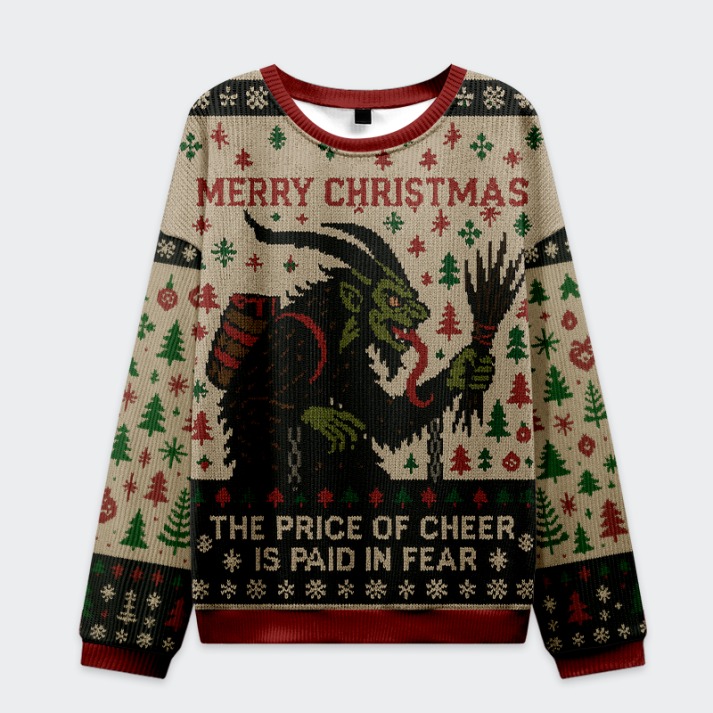Fashion is more than just clothing; it’s a cultural expression that tells stories of heritage, tradition, creativity, and innovation. Two iconic garments that embody this duality are the ugly Christmas sweater and the Japanese hoodie. At first glance, they seem to belong to entirely different worlds—one is cheerful and often humorous, reflecting the festive spirit of Western holiday traditions, while the other represents the sleek, minimalist, and innovative streetwear culture of Japan. Yet both garments have transcended their original purposes, becoming global icons that continue to influence modern style. By exploring their origins, cultural significance, unique design elements, and future directions, we discover how the ugly Christmas sweater and the Japanese hoodie reveal the playful and serious sides of fashion.
The Story Behind the Ugly Christmas Sweater
The ugly Christmas sweater first gained attention in the mid-20th century when it became common to wear knitwear featuring cheerful holiday motifs like snowflakes, Santa Claus, reindeer, and holly. In the 1980s and 1990s, these sweaters were gifted as warm, sentimental holiday apparel, often made by hand or purchased as seasonal novelties. However, as mainstream fashion evolved, they began to be seen as kitschy and outdated—earning the label “ugly.”
This ironic twist paved the way for the sweater’s resurgence in the early 2000s. The rise of themed parties, especially “Ugly Christmas Sweater Parties,” turned this garment into a symbol of humor, nostalgia, and festive camaraderie. Today, the ugly Christmas sweater is a holiday staple. With bold patterns, playful graphics, LED lights, and sometimes even 3D embellishments, it has transformed from a once-awkward holiday gift into a fashion trend that celebrates joy, creativity, and togetherness.
The Emergence and Evolution of the Japanese Hoodie
On the opposite end of the fashion spectrum lies the Japanese hoodie, a garment that emerged from Japan’s streetwear revolution in the 1990s and early 2000s. Rooted in the country’s dedication to craftsmanship and attention to detail, the hoodie became a canvas for blending Western casual wear with Japanese minimalism and artistry.
Japanese brands such as BAPE (A Bathing Ape), Undercover, Neighborhood, and Visvim elevated the hoodie from a simple sportswear item into a high-quality, style-conscious piece. Known for premium fabrics, meticulous stitching, and unique silhouettes, the Japanese hoodie embodies a culture of innovation and timeless design. Often featuring muted colors, asymmetrical cuts, or artistic graphics inspired by Japanese heritage, it redefines comfort and streetwear sophistication for a global audience.
Cultural Significance of the Ugly Christmas Sweater
The cultural power of the ugly Christmas sweater lies in its ability to bring people together. During the holiday season, wearing one is not just about fashion but about participating in a shared cultural moment. These sweaters evoke nostalgia, reminding people of simpler times and family traditions.
Many communities, workplaces, and charities have embraced the sweater’s popularity. Events like “National Ugly Christmas Sweater Day” encourage people to wear their most outrageous sweaters to raise funds for good causes. This festive piece of clothing has become a tool for unity and giving, proving that even something as simple as a sweater can have a positive social impact.
Cultural Impact of the Japanese Hoodie
The Japanese hoodie represents an entirely different, yet equally significant, cultural narrative. It reflects Japan’s influence on global streetwear and highlights how fashion can transcend borders. The hoodie’s design philosophy—balancing minimalism with thoughtful details—embodies Japanese aesthetics and appeals to modern, style-savvy individuals worldwide.
By elevating a casual garment into a refined fashion item, the Japanese hoodie has helped shift the perception of streetwear. Once considered informal or rebellious, hoodies are now recognized as versatile wardrobe staples that can be both stylish and functional. This cultural shift owes much to the innovation and craftsmanship of Japanese designers.
Design Characteristics of the Ugly Christmas Sweater
The design of the ugly Christmas sweater is intentionally bold, often featuring exaggerated colors, festive patterns, and humorous motifs. This playful aesthetic is what gives the sweater its unique charm. Classic elements include knitted snowmen, candy canes, reindeer, stars, or even animated elements like blinking lights.
Modern versions have pushed the boundaries further with 3D decorations such as pom-poms, faux fur, and even sound effects that play Christmas jingles. These sweaters are not about subtlety—they’re designed to be conversation starters, encouraging wearers to embrace the fun and whimsical side of the holiday season.
Design Philosophy of the Japanese Hoodie
The Japanese hoodie, in contrast, thrives on subtle sophistication. Japanese designers prioritize premium fabrics like heavyweight cotton, French terry, and organic blends, ensuring both durability and comfort. The construction often features oversized or boxy silhouettes, precise stitching, and innovative details like asymmetrical zippers, concealed pockets, or minimalistic embroidery.
Rather than loud logos or flashy patterns, many Japanese hoodies focus on neutral colors like black, gray, beige, or earthy tones. When graphics are present, they often draw inspiration from traditional Japanese art forms such as calligraphy, ukiyo-e prints, or cultural symbols like koi fish or cherry blossoms. This fusion of heritage and modern design elevates the hoodie into a statement piece.
How to Style an Ugly Christmas Sweater
Styling the ugly Christmas sweater is all about balance. Because the sweater itself is usually vibrant and attention-grabbing, pairing it with neutral bottoms such as black jeans, dark skirts, or simple leggings creates harmony in the outfit.
For casual holiday gatherings, it pairs well with sneakers or ankle boots. For office parties or slightly more formal events, you can dress it up by pairing it with tailored trousers and heeled boots. Adding festive accessories like Santa hats, holiday-themed earrings, or reindeer antlers can enhance the playful spirit. The key to wearing an ugly Christmas sweater is to embrace its charm with confidence and a sense of humor.
How to Style a Japanese Hoodie
The Japanese hoodie offers unmatched versatility when it comes to styling. For an urban streetwear vibe, it pairs effortlessly with loose-fit cargo pants, joggers, and sneakers. To achieve a more polished look, it can be layered under a structured overcoat or worn with slim-fit trousers and sleek boots.
Its neutral tones make it a great base for both minimalist and experimental outfits. The Japanese hoodie can easily transition between casual and semi-formal settings, reflecting its role as a cornerstone of modern streetwear fashion. Accessories like simple beanies, crossbody bags, or clean sneakers further enhance its understated appeal.
The Role of Social Media in Popularizing These Styles
Social media platforms like Instagram, TikTok, and Pinterest have played a crucial role in spreading the popularity of both the ugly Christmas sweater and the Japanese hoodie. Influencers and celebrities showcase their styling choices online, inspiring followers to adopt these trends.
Seasonal hashtags like #UglyChristmasSweater dominate social media during December, while streetwear enthusiasts share their curated collections of Japanese hoodies year-round. This digital exposure has allowed both garments to reach global audiences, turning them into lasting fashion staples that transcend cultural and geographical boundaries.
Sustainability and the Future of These Iconic Garments
With the fashion industry’s growing focus on sustainability, both the ugly Christmas sweater and the Japanese hoodie have adapted to meet eco-conscious consumer demands. Many brands now produce sweaters using recycled or upcycled materials, encouraging customers to buy second-hand or vintage pieces.
Similarly, the slow-fashion approach behind the Japanese hoodie, which emphasizes quality and durability over mass production, aligns with sustainable fashion values. Consumers are increasingly seeking clothing that lasts longer and has a lower environmental footprint, ensuring that these iconic garments remain relevant for years to come.
The Enduring Appeal of Tradition and Innovation
The enduring success of the ugly Christmas sweater lies in its ability to evoke joy and shared experiences during the holiday season. Its playful designs invite people to celebrate traditions in a lighthearted way. Meanwhile, the Japanese hoodie continues to represent innovation, craftsmanship, and contemporary streetwear aesthetics, appealing to those who value both comfort and style.
Together, these garments prove that fashion is not bound by geography or season. The ugly Christmas sweater thrives in its festive context, while the Japanese hoodie transcends seasons and trends, representing a versatile and timeless approach to urban fashion.
Conclusion – Bridging Festive Nostalgia and Urban Innovation
The ugly Christmas sweater and the Japanese hoodie showcase two very different yet equally impactful sides of fashion. One is rooted in holiday traditions and cheerful humor, bringing communities together during the most joyful time of the year. The other represents innovation and refined streetwear culture, redefining casual fashion for the modern era.
Both garments demonstrate that fashion is more than just clothing—it’s a language of culture, personality, and identity. Whether you’re donning a playful ugly Christmas sweater for a family holiday party or stepping out in a sleek Japanese hoodie for a stylish city stroll, you are part of a global narrative that celebrates both tradition and innovation. In doing so, these two garments continue to inspire and connect people across generations and cultures.



